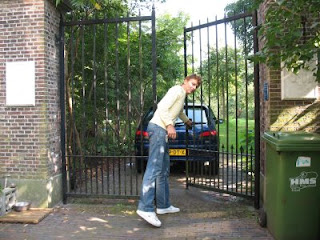This is the tourist
Red double decker bus.
(Imported from London) There are 2 tour bus route at Malacca (Melaka),
Blue &
Red Line. The double decker bus is the
Red route (Line). The journey of the
Red Bus pass through 13 interesting points within the City Center.

It route start from :-
1) Hang Tuah Mall - Shopping Mall
2) Chetty Village (Kampung in Malay) - Chettys are
straits-born Indians and offspring of Indian traders who came from Panai.
3) Jonker Walk - One of the tourist attraction. You can find numerous of shops selling antiques, souvenirs, furniture, cafe and many more.....
4) Kampung Hulu Mosque - The Mosque of Hulu Village was built in
1728 by
Dato Shamsuddin and it is the
oldest mosque in Malaysia.
5) Stadhuys - The
Stadhuys (1650) was the official residence of the
Dutch Governor. It now houses the Historic & Ethnography Museum which has many traditional bridal costumes and relics on display.
6) Museum Samudera - Malacca (Melaka) Maritime Archaeology Museum.
 7) Dataran Pahlawan
7) Dataran Pahlawan - The
largest shopping mall in Malacca.
8) Hotel Equatorial - The 5 star International Business Class Hotel in Malacca.
9) Bukit Senjuang -
St. John's Hill Fortress. Reconstructed by the
Dutch in the third quarter of the
18th century, the cannons in this fort point inwards towards the mainland because at that time, the threat to Malacca was mainly from inland rather than the sea.
10) Jalan Laksamana Cheng Ho - Budget Hotels and shops are situated in this street.
11) Hang Li Poh Well - The
oldest well in Malacca (Melaka), was built in
1459 by the followers of
Hang Li Poh, the Chinese Princess who married the Sultan of Malacca. In the olden days, the well
never dried up and was the only source of water during the
great drought.
12) Morten Village - The village was found in early 1920s and named after J.F. Morten, the land commissioner. It is the only Malay Traditional Village located in the middle of the city which retains the traditional lifestyle, culture and architecture.
13) Hotel Renaissance - The hotel was built in 1984, recently refurbished the hotel to the modern facilities.
And last, back to
Hang Tuah Mall.
The bus fares (for the
Red &
Blue Line) are
MYR5.00 for adult &
MYR2.50 for children. The fares you pay are all
'Day Ticket'. That's mean you can get down any bus stop and come back from any bus stop without limits.
One ticket for
both Tour Bus. Tickets are selling
onboard.
The interval for both lines are
30 to
45 minutes.
Actually we have very limit time this trip, so I plan it to my next trip for the ride of the Red & Blue lines Tour Bus.
Related Melaka post :-
* An Evening at Malacca (Melaka)
* Stadhuys, Malacca (Melaka)
* St. Paul's Church, Malacca
* Aldy Hotel, Malacca (Melaka)
* Jonker Walk Night Market, Malacca (Melaka)
* Ole Sayang Nyonya Food Restaurant, Malacca (Melaka)
* Malacca (Melaka) River Cruise
* Dim Sum Restaurant at Malacca
* Special Homemade Herbal Tea at Malacca
* Portuguese Village, Malacca (Melaka)
* Famous Malacca's Popiah
* Hotel Equatorial, Malacca
* Taiwan Beef Noodle Malacca
* Nyonya Suan Restaurant, Malacca
* Mahkota Parade, Malacca
* Malacca (Melaka)
MY TRIPS - Home



